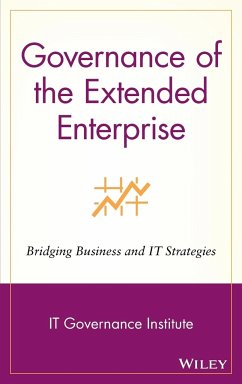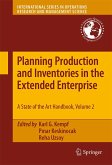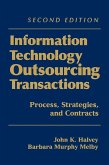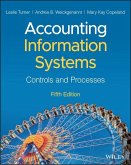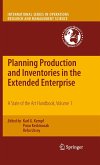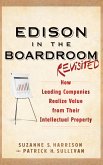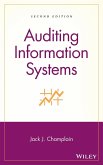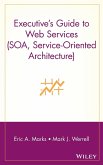- Gebundenes Buch
- Merkliste
- Auf die Merkliste
- Bewerten Bewerten
- Teilen
- Produkt teilen
- Produkterinnerung
- Produkterinnerung
Discover how to implement an effective IT governance structure for the long-term success of an extended enterprise IT is no longer an enabler of corporate strategy, it is now the key element of corporate strategy. Governance of the Extended Enterprise explores how some of the world's most successful enterprises have integrated information technology with business strategies, culture, and ethics to optimize information value, attain business objectives, and capitalize on technologies in highly competitive environments. Providing a process for change and a governance model, Governance of the…mehr
Andere Kunden interessierten sich auch für
![Planning Production and Inventories in the Extended Enterprise Planning Production and Inventories in the Extended Enterprise]() Planning Production and Inventories in the Extended Enterprise188,99 €
Planning Production and Inventories in the Extended Enterprise188,99 €![Information Technology Outsourcing Transactions Information Technology Outsourcing Transactions]() John K HalveyInformation Technology Outsourcing Transactions258,99 €
John K HalveyInformation Technology Outsourcing Transactions258,99 €![Accounting Information Systems Accounting Information Systems]() Leslie TurnerAccounting Information Systems164,99 €
Leslie TurnerAccounting Information Systems164,99 €![Planning Production and Inventories in the Extended Enterprise, Volume 1 Planning Production and Inventories in the Extended Enterprise, Volume 1]() Planning Production and Inventories in the Extended Enterprise, Volume 1117,99 €
Planning Production and Inventories in the Extended Enterprise, Volume 1117,99 €![Edison in the Boardroom Revisited Edison in the Boardroom Revisited]() Suzanne S. HarrisonEdison in the Boardroom Revisited44,99 €
Suzanne S. HarrisonEdison in the Boardroom Revisited44,99 €![Auditing Information Systems Auditing Information Systems]() Jack J ChamplainAuditing Information Systems165,99 €
Jack J ChamplainAuditing Information Systems165,99 €![Executive's Guide to Web Services Executive's Guide to Web Services]() Eric A MarksExecutive's Guide to Web Services48,99 €
Eric A MarksExecutive's Guide to Web Services48,99 €-
-
-
Discover how to implement an effective IT governance structure for the long-term success of an extended enterprise IT is no longer an enabler of corporate strategy, it is now the key element of corporate strategy. Governance of the Extended Enterprise explores how some of the world's most successful enterprises have integrated information technology with business strategies, culture, and ethics to optimize information value, attain business objectives, and capitalize on technologies in highly competitive environments. Providing a process for change and a governance model, Governance of the Extended Enterprise encompasses the latest emerging practices from major information and knowledge businesses, providing a major new knowledge resource for enterprises. It also opens up new avenues of practice in strategy setting, enterprise management, control assessment, and risk management. From sales-force automation to workgroup collaboration, forms processing to knowledge management systems, customer service to technical support, Governance of the Extended Enterprise will help readers improve IT governance in all facets of their organization.
Hinweis: Dieser Artikel kann nur an eine deutsche Lieferadresse ausgeliefert werden.
Hinweis: Dieser Artikel kann nur an eine deutsche Lieferadresse ausgeliefert werden.
Produktdetails
- Produktdetails
- Verlag: Wiley
- Seitenzahl: 205
- Erscheinungstermin: 3. Februar 2005
- Englisch
- Abmessung: 240mm x 161mm x 17mm
- Gewicht: 507g
- ISBN-13: 9780471334439
- ISBN-10: 047133443X
- Artikelnr.: 22318416
- Herstellerkennzeichnung
- Libri GmbH
- Europaallee 1
- 36244 Bad Hersfeld
- gpsr@libri.de
- Verlag: Wiley
- Seitenzahl: 205
- Erscheinungstermin: 3. Februar 2005
- Englisch
- Abmessung: 240mm x 161mm x 17mm
- Gewicht: 507g
- ISBN-13: 9780471334439
- ISBN-10: 047133443X
- Artikelnr.: 22318416
- Herstellerkennzeichnung
- Libri GmbH
- Europaallee 1
- 36244 Bad Hersfeld
- gpsr@libri.de
THE IT GOVERNANCE INSTITUTE® (ITGI) (www.itgi.org) was established in 1998 to advance international thinking and standards in directing and controlling an enterprise's information technology. Effective IT governance helps ensure that IT supports business goals, optimizes business investment in IT, and appropriately manages IT-related risks and opportunities. The IT Governance Institute offers symposia, original research, and case studies to assist enterprise leaders and boards of directors in their IT governance responsibilities. INFORMATION SYSTEMS AUDIT AND CONTROL ASSOCIATION® (ISACA®) (www.isaca.org) is a recognized worldwide leader in IT governance, control, security, and assurance with more than 35,000 members in more than 100 countries. Founded in 1969, ISACA sponsors international conferences; publishes the Information Systems Control JournalTM; develops international information systems auditing and control standards; and administers both the globally respected Certified Information System Auditor® (CISA®) designation carried by more than 35,000 professionals since its inception, and the Certified Information Security Manager (CISMTM) designation, a groundbreaking credential earned by 5,000 professionals in its first two years.
Acknowledgments.
Preface.
Introduction.
Managing Change as a Business Process.
How Do We Get There from Here?
Vision/Leadership.
Value Creation and Performance Management.
Governance Framework and Criteria.
Governance Officer.
Enterprise Architecture: Framework and Implementation.
Reference Works.
Looking Forward.
1. Extended Enterprises.
Change Agents in the Extended Enterprise Environment.
Paradigm Shift in the Business Environment/Changes in Processes.
2. Strategy: Challenge for the Extended Enterprise.
Business Strategy Challenge.
New Enterprise Risk Management Structures.
New Regulatory Compliance Challenge.
Developing Strategy with Value Innovation.
Transforming Internal Governance Strategy.
New Internal Governance Challenge.
Governance Challenge.
Bridging the Gap between the Information Technology Organization and
Internal Clients.
Making Strategy a Continual Process: Coevolving and Patching.
Managing Knowledge for Better Communication: Knowledge Management.
Sharing Knowledge through a Knowledge Portal.
3. Value Creation and Management of Performance in the Extended Enterprise.
Vision and Mission.
Value Creation and Strategy Implications.
Necessity of a Core Repository of Knowledge Portal.
Suggested Architecture for Performance Measurement.
Delegate and Empower through Performance Management.
Framework for Measurement.
Control Objectives for Information and Related Technology.
Monitoring: Measuring and Comparing Outcomes for Improvements.
Ongoing Strategy Process: Operational Performance Monitoring.
4. Operational Business Activities: Value Realization for the Extended
Enterprise.
Value Realization.
Blueprint for Knowledge Sharing in an Extended Enterprise.
Objectives, Goals, and Expectations.
Information and Knowledge Resources (Intangible Business Resources).
Information Sharing Activities (Two-way Communication).
Operational Business Activities.
Tangible Business Resources.
Value Creation Cycle.
5. Governance Framework for the Extended Enterprise.
Governance Definition.
Enterprise Governance Challenge in the Extended Enterprise.
Governance Structure for the Extended Enterprise.
Governance Objectives for the Extended Enterprise.
Comparison with Excellence Models.
Leadership: Driver for Values and Governance Implementation.
Maturity Levels of Leadership.
Maturity Model for Evaluating the Level of Governance of the Extended
Enterprise.
Tools for the Governance of the Extended Enterprise.
6. Enterprise Architecture: Governance Implementation for the Extended
Enterprise.
What Is Enterprise Architecture?
Enterprise Architecture: New Focus for Chief Information Officers.
Architecture Layers Interrelationships.
Implementing and Maintaining the Enterprise Architecture.
Information Technology Governance in the Extended Enterprise.
Strategic Alignment of IT Strategies with the Business.
IT Infrastructure to Enable Business.
Maturity Model of the Enterprise Architecture/IT Architecture.
Partner Ability for Networking/Information Flows and Relationships.
Maturity Model for IT Governance.
Establish Information Model and Data Model for Quick Implementation of a
Knowledge Base.
Appendices.
A: Questions for the Board and Senior Management.
B: Performance Reference Model.
C: Organizational Structure Evolution: Core versus Central.
D: Framework and Quality Awards.
E: Business Reference Model.
F: Knowledge Work, Knowledge Management, and Knowledge Portal.
G: Enterprise Architecture Processes at Different Maturity Levels.
H: Maturity Model for Business Activities in the Extended Enterprise.
I: IT Governance.
J: IT Governance Maturity Model.
K: COBIT Information Processes.
Glossary.
References.
Other ITGI Publications.
Index.
Preface.
Introduction.
Managing Change as a Business Process.
How Do We Get There from Here?
Vision/Leadership.
Value Creation and Performance Management.
Governance Framework and Criteria.
Governance Officer.
Enterprise Architecture: Framework and Implementation.
Reference Works.
Looking Forward.
1. Extended Enterprises.
Change Agents in the Extended Enterprise Environment.
Paradigm Shift in the Business Environment/Changes in Processes.
2. Strategy: Challenge for the Extended Enterprise.
Business Strategy Challenge.
New Enterprise Risk Management Structures.
New Regulatory Compliance Challenge.
Developing Strategy with Value Innovation.
Transforming Internal Governance Strategy.
New Internal Governance Challenge.
Governance Challenge.
Bridging the Gap between the Information Technology Organization and
Internal Clients.
Making Strategy a Continual Process: Coevolving and Patching.
Managing Knowledge for Better Communication: Knowledge Management.
Sharing Knowledge through a Knowledge Portal.
3. Value Creation and Management of Performance in the Extended Enterprise.
Vision and Mission.
Value Creation and Strategy Implications.
Necessity of a Core Repository of Knowledge Portal.
Suggested Architecture for Performance Measurement.
Delegate and Empower through Performance Management.
Framework for Measurement.
Control Objectives for Information and Related Technology.
Monitoring: Measuring and Comparing Outcomes for Improvements.
Ongoing Strategy Process: Operational Performance Monitoring.
4. Operational Business Activities: Value Realization for the Extended
Enterprise.
Value Realization.
Blueprint for Knowledge Sharing in an Extended Enterprise.
Objectives, Goals, and Expectations.
Information and Knowledge Resources (Intangible Business Resources).
Information Sharing Activities (Two-way Communication).
Operational Business Activities.
Tangible Business Resources.
Value Creation Cycle.
5. Governance Framework for the Extended Enterprise.
Governance Definition.
Enterprise Governance Challenge in the Extended Enterprise.
Governance Structure for the Extended Enterprise.
Governance Objectives for the Extended Enterprise.
Comparison with Excellence Models.
Leadership: Driver for Values and Governance Implementation.
Maturity Levels of Leadership.
Maturity Model for Evaluating the Level of Governance of the Extended
Enterprise.
Tools for the Governance of the Extended Enterprise.
6. Enterprise Architecture: Governance Implementation for the Extended
Enterprise.
What Is Enterprise Architecture?
Enterprise Architecture: New Focus for Chief Information Officers.
Architecture Layers Interrelationships.
Implementing and Maintaining the Enterprise Architecture.
Information Technology Governance in the Extended Enterprise.
Strategic Alignment of IT Strategies with the Business.
IT Infrastructure to Enable Business.
Maturity Model of the Enterprise Architecture/IT Architecture.
Partner Ability for Networking/Information Flows and Relationships.
Maturity Model for IT Governance.
Establish Information Model and Data Model for Quick Implementation of a
Knowledge Base.
Appendices.
A: Questions for the Board and Senior Management.
B: Performance Reference Model.
C: Organizational Structure Evolution: Core versus Central.
D: Framework and Quality Awards.
E: Business Reference Model.
F: Knowledge Work, Knowledge Management, and Knowledge Portal.
G: Enterprise Architecture Processes at Different Maturity Levels.
H: Maturity Model for Business Activities in the Extended Enterprise.
I: IT Governance.
J: IT Governance Maturity Model.
K: COBIT Information Processes.
Glossary.
References.
Other ITGI Publications.
Index.
Acknowledgments.
Preface.
Introduction.
Managing Change as a Business Process.
How Do We Get There from Here?
Vision/Leadership.
Value Creation and Performance Management.
Governance Framework and Criteria.
Governance Officer.
Enterprise Architecture: Framework and Implementation.
Reference Works.
Looking Forward.
1. Extended Enterprises.
Change Agents in the Extended Enterprise Environment.
Paradigm Shift in the Business Environment/Changes in Processes.
2. Strategy: Challenge for the Extended Enterprise.
Business Strategy Challenge.
New Enterprise Risk Management Structures.
New Regulatory Compliance Challenge.
Developing Strategy with Value Innovation.
Transforming Internal Governance Strategy.
New Internal Governance Challenge.
Governance Challenge.
Bridging the Gap between the Information Technology Organization and
Internal Clients.
Making Strategy a Continual Process: Coevolving and Patching.
Managing Knowledge for Better Communication: Knowledge Management.
Sharing Knowledge through a Knowledge Portal.
3. Value Creation and Management of Performance in the Extended Enterprise.
Vision and Mission.
Value Creation and Strategy Implications.
Necessity of a Core Repository of Knowledge Portal.
Suggested Architecture for Performance Measurement.
Delegate and Empower through Performance Management.
Framework for Measurement.
Control Objectives for Information and Related Technology.
Monitoring: Measuring and Comparing Outcomes for Improvements.
Ongoing Strategy Process: Operational Performance Monitoring.
4. Operational Business Activities: Value Realization for the Extended
Enterprise.
Value Realization.
Blueprint for Knowledge Sharing in an Extended Enterprise.
Objectives, Goals, and Expectations.
Information and Knowledge Resources (Intangible Business Resources).
Information Sharing Activities (Two-way Communication).
Operational Business Activities.
Tangible Business Resources.
Value Creation Cycle.
5. Governance Framework for the Extended Enterprise.
Governance Definition.
Enterprise Governance Challenge in the Extended Enterprise.
Governance Structure for the Extended Enterprise.
Governance Objectives for the Extended Enterprise.
Comparison with Excellence Models.
Leadership: Driver for Values and Governance Implementation.
Maturity Levels of Leadership.
Maturity Model for Evaluating the Level of Governance of the Extended
Enterprise.
Tools for the Governance of the Extended Enterprise.
6. Enterprise Architecture: Governance Implementation for the Extended
Enterprise.
What Is Enterprise Architecture?
Enterprise Architecture: New Focus for Chief Information Officers.
Architecture Layers Interrelationships.
Implementing and Maintaining the Enterprise Architecture.
Information Technology Governance in the Extended Enterprise.
Strategic Alignment of IT Strategies with the Business.
IT Infrastructure to Enable Business.
Maturity Model of the Enterprise Architecture/IT Architecture.
Partner Ability for Networking/Information Flows and Relationships.
Maturity Model for IT Governance.
Establish Information Model and Data Model for Quick Implementation of a
Knowledge Base.
Appendices.
A: Questions for the Board and Senior Management.
B: Performance Reference Model.
C: Organizational Structure Evolution: Core versus Central.
D: Framework and Quality Awards.
E: Business Reference Model.
F: Knowledge Work, Knowledge Management, and Knowledge Portal.
G: Enterprise Architecture Processes at Different Maturity Levels.
H: Maturity Model for Business Activities in the Extended Enterprise.
I: IT Governance.
J: IT Governance Maturity Model.
K: COBIT Information Processes.
Glossary.
References.
Other ITGI Publications.
Index.
Preface.
Introduction.
Managing Change as a Business Process.
How Do We Get There from Here?
Vision/Leadership.
Value Creation and Performance Management.
Governance Framework and Criteria.
Governance Officer.
Enterprise Architecture: Framework and Implementation.
Reference Works.
Looking Forward.
1. Extended Enterprises.
Change Agents in the Extended Enterprise Environment.
Paradigm Shift in the Business Environment/Changes in Processes.
2. Strategy: Challenge for the Extended Enterprise.
Business Strategy Challenge.
New Enterprise Risk Management Structures.
New Regulatory Compliance Challenge.
Developing Strategy with Value Innovation.
Transforming Internal Governance Strategy.
New Internal Governance Challenge.
Governance Challenge.
Bridging the Gap between the Information Technology Organization and
Internal Clients.
Making Strategy a Continual Process: Coevolving and Patching.
Managing Knowledge for Better Communication: Knowledge Management.
Sharing Knowledge through a Knowledge Portal.
3. Value Creation and Management of Performance in the Extended Enterprise.
Vision and Mission.
Value Creation and Strategy Implications.
Necessity of a Core Repository of Knowledge Portal.
Suggested Architecture for Performance Measurement.
Delegate and Empower through Performance Management.
Framework for Measurement.
Control Objectives for Information and Related Technology.
Monitoring: Measuring and Comparing Outcomes for Improvements.
Ongoing Strategy Process: Operational Performance Monitoring.
4. Operational Business Activities: Value Realization for the Extended
Enterprise.
Value Realization.
Blueprint for Knowledge Sharing in an Extended Enterprise.
Objectives, Goals, and Expectations.
Information and Knowledge Resources (Intangible Business Resources).
Information Sharing Activities (Two-way Communication).
Operational Business Activities.
Tangible Business Resources.
Value Creation Cycle.
5. Governance Framework for the Extended Enterprise.
Governance Definition.
Enterprise Governance Challenge in the Extended Enterprise.
Governance Structure for the Extended Enterprise.
Governance Objectives for the Extended Enterprise.
Comparison with Excellence Models.
Leadership: Driver for Values and Governance Implementation.
Maturity Levels of Leadership.
Maturity Model for Evaluating the Level of Governance of the Extended
Enterprise.
Tools for the Governance of the Extended Enterprise.
6. Enterprise Architecture: Governance Implementation for the Extended
Enterprise.
What Is Enterprise Architecture?
Enterprise Architecture: New Focus for Chief Information Officers.
Architecture Layers Interrelationships.
Implementing and Maintaining the Enterprise Architecture.
Information Technology Governance in the Extended Enterprise.
Strategic Alignment of IT Strategies with the Business.
IT Infrastructure to Enable Business.
Maturity Model of the Enterprise Architecture/IT Architecture.
Partner Ability for Networking/Information Flows and Relationships.
Maturity Model for IT Governance.
Establish Information Model and Data Model for Quick Implementation of a
Knowledge Base.
Appendices.
A: Questions for the Board and Senior Management.
B: Performance Reference Model.
C: Organizational Structure Evolution: Core versus Central.
D: Framework and Quality Awards.
E: Business Reference Model.
F: Knowledge Work, Knowledge Management, and Knowledge Portal.
G: Enterprise Architecture Processes at Different Maturity Levels.
H: Maturity Model for Business Activities in the Extended Enterprise.
I: IT Governance.
J: IT Governance Maturity Model.
K: COBIT Information Processes.
Glossary.
References.
Other ITGI Publications.
Index.

